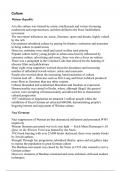Culture
Weimar Republic
Art elite culture was formed by artists, intellectuals and writers favouring
modernism and expressionism, and then shifted to the Neue Sachlichkeit
movement
The movement influences art, music, literature, opera and theatre, highly valued
by the rich
Government subsidised culture by paying for theatres, orchestras and museums
to bring culture to small towns
However, subsidies were small and social welfare took priority
Popular culture led by young people in urban areas heavily influenced by
consumer culture, advertising and music, there was also a focus on realism
There was a paragraph in the Criminal Code that allowed for the banning of
obscene films and publications
Many right-wing supporters worried about the decadence and increasing
number of influential Jewish writers, artists and musicians
People also worried about the increasing Americanisation of culture
Cinema took off — Directors such as Fritz Lang and Ernst Lubitsch produced
more films in Germany than any other country
Cabaret flourished and symbolised liberalism and freedom of expression
Homosexuality was coined in Berlin, where, although illegal, the general
society were accepting of homosexuality and allowed this to characterise
cultural progression
1937 exhibition of degenerate art attracted 2 million people whilst the
exhibition of Great German art attracted 600,000, demonstrating people’s
lingering interest and enjoyment of Weimar culture
Nazi Germany
Nazi suppression of Weimar art that denounced militarism and presented WWI
negatively
Weimar literature presented war in its true light — Erich Maria Remarque’s All
Quiet on the Western Front was banned by the Nazis
1933 book burning with over 25,000 books destroyed, these were mainly books
by Jewish authors
Strength Through Joy programme subsidised theatre, opera and art gallery trips
to expose the population to great German culture
The Bauhaus movement was closed by the Nazis in 1933 who wanted to revive
German culture
However, elements of Bauhaus remained and some architects still used modern
techniques




